Unified Payments Interface (UPI) has transformed the landscape of digital payments in India, enabling seamless UPI transactions across platforms like Google Pay, PhonePe, and Paytm. As UPI payment in India grew exponentially, ensuring reliability through rigorous load testing, performance testing, and security testing became crucial. With increasing UPI registration and integration into everyday life, the security of digital payments and system scalability were tested using advanced tools like JMeter load testing, K6 load testing, and Gatling load testing. This blog explores how UPI in India became the backbone of the digital payments platform, powered by robust automation testing strategies and testing innovation.
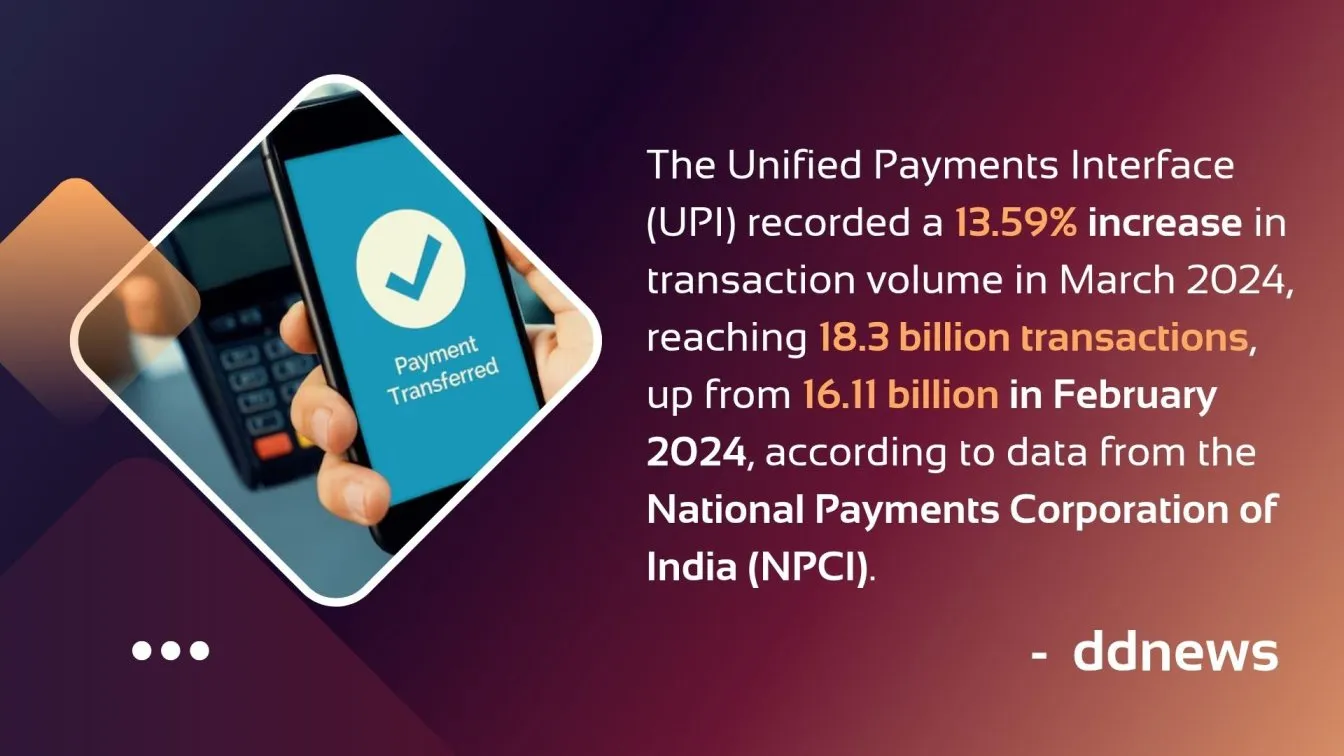
What’s next? Keep scrolling to find out:
🚀 UPI's Digital Revolution: How UPI transformed India’s digital payments.
🚀 Key Features & Testing: Essential features and testing strategies ensuring UPI’s reliability.
🚀 Scalability & Performance: Managing high transaction volumes through scalable architecture.
🚀 API Integration & Automation: Enhancing user experience with integration APIs and automated testing.
🚀 Non-Functional Testing & Optimization: Ensuring UPI’s efficiency with robust testing and backend optimization.
What Is UPI and Why It Revolutionized Digital Payments in India
UPI (Unified Payments Interface) has dramatically transformed how transactions occur in the Indian financial ecosystem. Designed for simplicity, scalability, and security, it integrates multiple bank accounts into a single mobile platform and enables real-time fund transfers. Here's how it revolutionized the digital payment landscape:
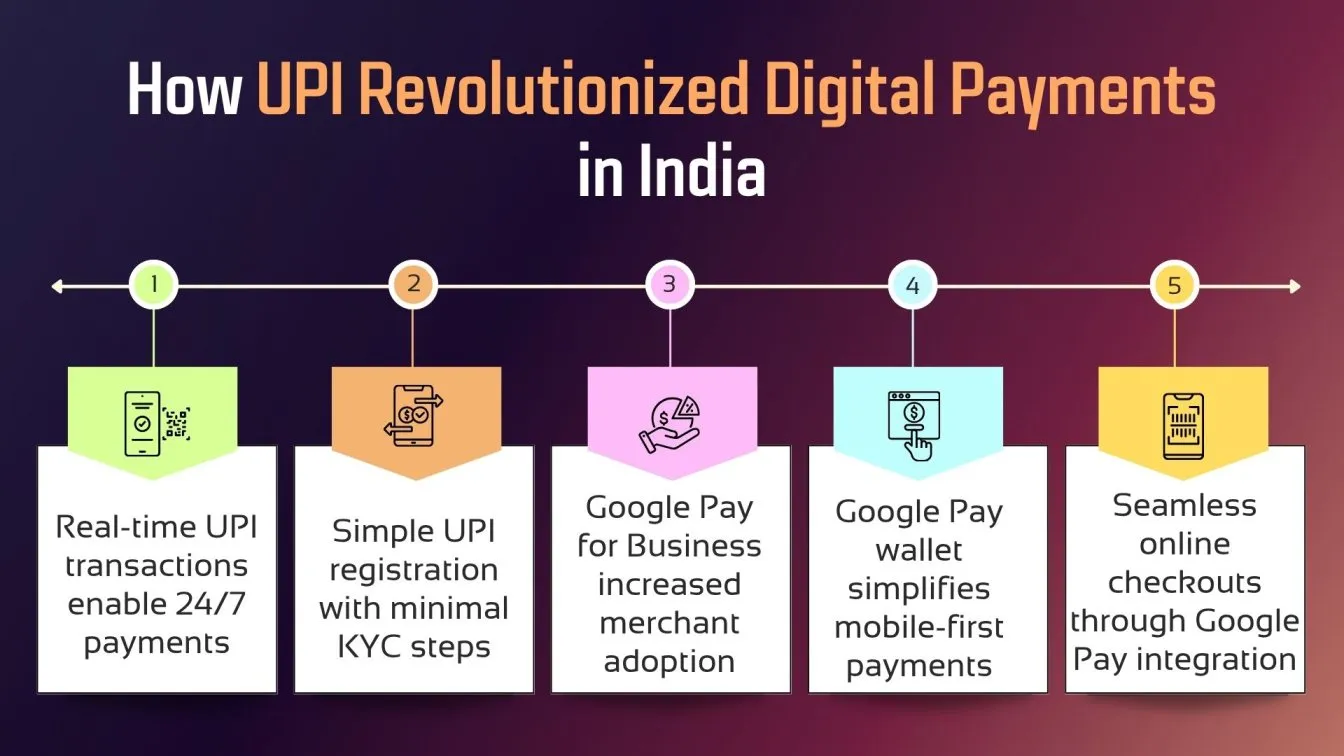
- UPI payments have made money transfers easier by removing the need for entering bank details, offering a hassle-free experience.
- Real-time UPI transactions are now possible 24/7, even on holidays, enabling smooth payments across different banks.
- The rise of UPI payment in India has positioned the country as a global leader in instant, mobile-based financial systems.
- Google Pay for business has encouraged more merchants to go digital by offering a fast and reliable payment acceptance platform.
- Setting up a Google Pay account is quick and straightforward. Users can link their bank accounts and start transacting instantly.
- The Google Pay wallet supports a mobile-first lifestyle by reducing the need for carrying physical wallets during transactions.
- Through Google Pay online, users enjoy seamless payment experiences during e-commerce checkouts and when paying for digital services.
- UPI registration is streamlined with minimal KYC requirements, making it easy for users to activate and use UPI through mobile apps.
Key Features That Make UPI a Trusted Digital Payment System
Unified Payments Interface (UPI) has transformed India’s digital payment ecosystem by offering a seamless, fast, and secure transaction experience. It has not only strengthened digital payment infrastructure but also accelerated financial inclusion across urban and rural landscapes. The following features have contributed to UPI becoming a trusted digital payment system in the Indian economy.
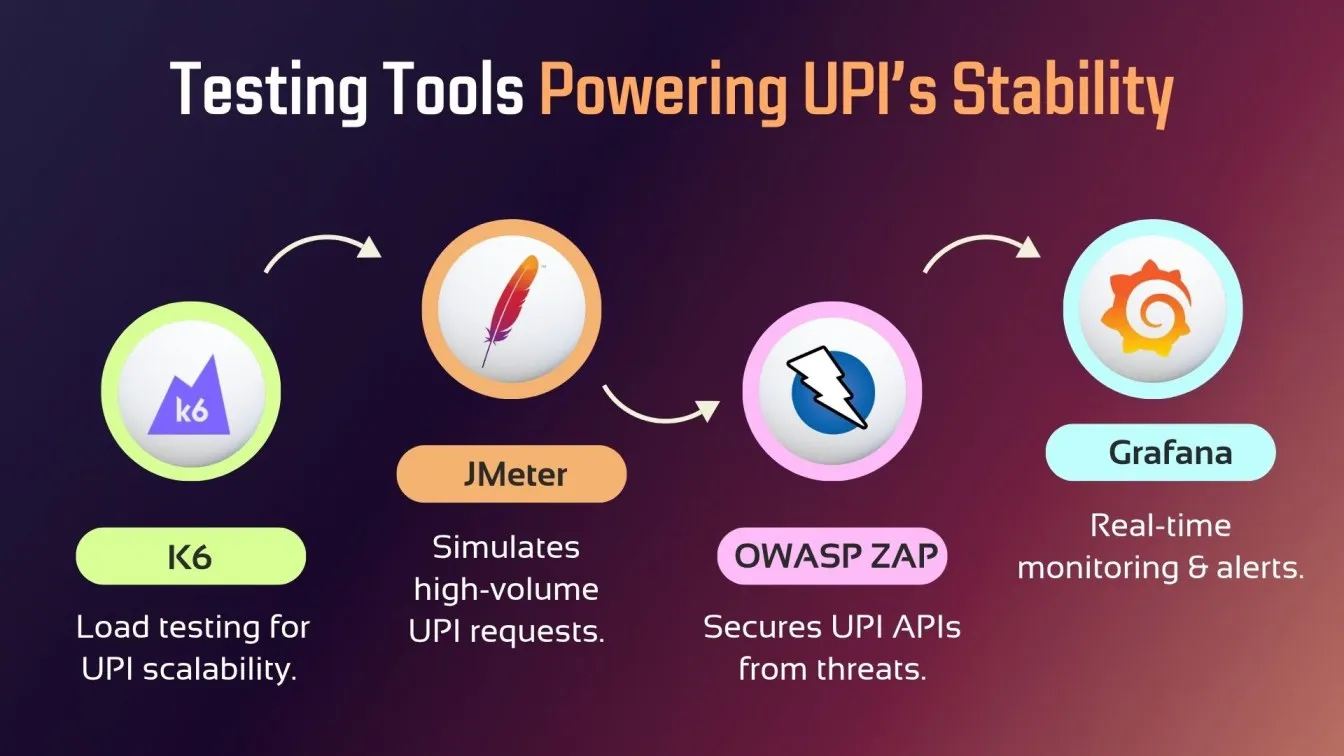
- Real-time payment system: Enables instant fund transfer between bank account details without delays, improving the ease of transaction.
- Ease of payment: UPI simplifies complex processes like cross-border remittances and small business payments through mobile phones and digital wallets.
- Conversational Voice Payments: Emerging tech allows voice-based UPI transactions, enhancing accessibility for the elderly and visually impaired.
- Strict data regulations: Adheres to consumer protection standards enforced by the National Payments Corporation, ensuring secure transactions.
- Government programs: Active support from initiatives like Digital India has fueled widespread adoption.
The Role of Load Testing in Ensuring UPI Scalability
As UPI payments continue to power millions of transactions daily, ensuring platform scalability is critical. With the surge in digital payment solutions like Google Pay, PhonePe, and Paytm, the load testing process becomes essential to validate how UPI performs under varying levels of demand. It guarantees smooth UPI transaction experiences even during peak hours and festive seasons.

- Load testing plays a vital role in simulating massive user traffic on UPI servers, ensuring they can handle real-world transaction volumes from millions of active users.
- It helps detect performance issues in APIs that support UPI (Unified Payment Interface) architecture, allowing teams to resolve bottlenecks before they impact users.
- By assessing backend response times and system behavior under stress, load testing ensures uninterrupted operation of UPI pay systems during peak hours.
- It also evaluates the performance of offline payments and mobile application loads, maintaining smooth functionality across various platforms.
- Overall, load testing software boosts the reliability of apps like Google Pay wallet, supporting fast, secure, and seamless transactions for users across India.
Ensuring Secure Digital Transactions Through API Load Testing
With the rapid growth of digital payments in India, ensuring secure and seamless API performance has become a top priority for platforms like the Google Pay app and UPI in India. API load testing plays a pivotal role in validating the strength and responsiveness of APIs that facilitate millions of real-time payment system transactions daily. This method guarantees transaction integrity even during traffic spikes.
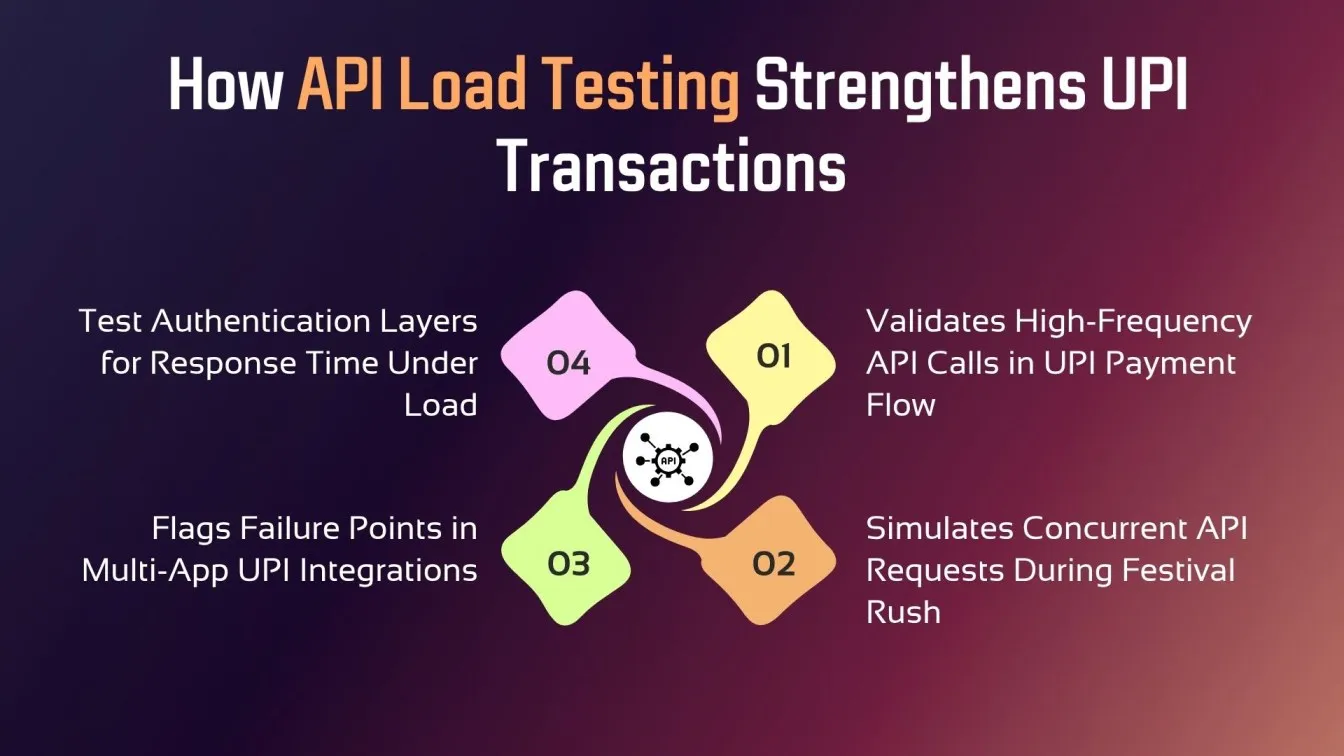
- API Stability: API performance testing ensures responsiveness under high-load conditions in the digital payments ecosystem.
- Critical Bottlenecks: Performance testing tools identify delays in UPI registration and bank account verification.
- Wallet Scalability: K6 performance testing validates API reliability for digital wallets amid growing bank-fintech partnerships.
- User Protection: Security testing services integrate with API load tests to enhance consumer protection and cross-border integration.
- Access Security: Cyber security penetration testing prevents unauthorized access in digital financial infrastructures.
Performance Testing Strategies Used in UPI Transactions
To ensure UPI payments remain reliable and efficient, performance testing strategies are essential for handling high transaction volumes. With millions of active users relying on UPI transactions, robust performance testing methodologies are crucial for seamless operation. These strategies ensure that UPI can handle spikes in demand, ensuring smooth and secure financial operations.
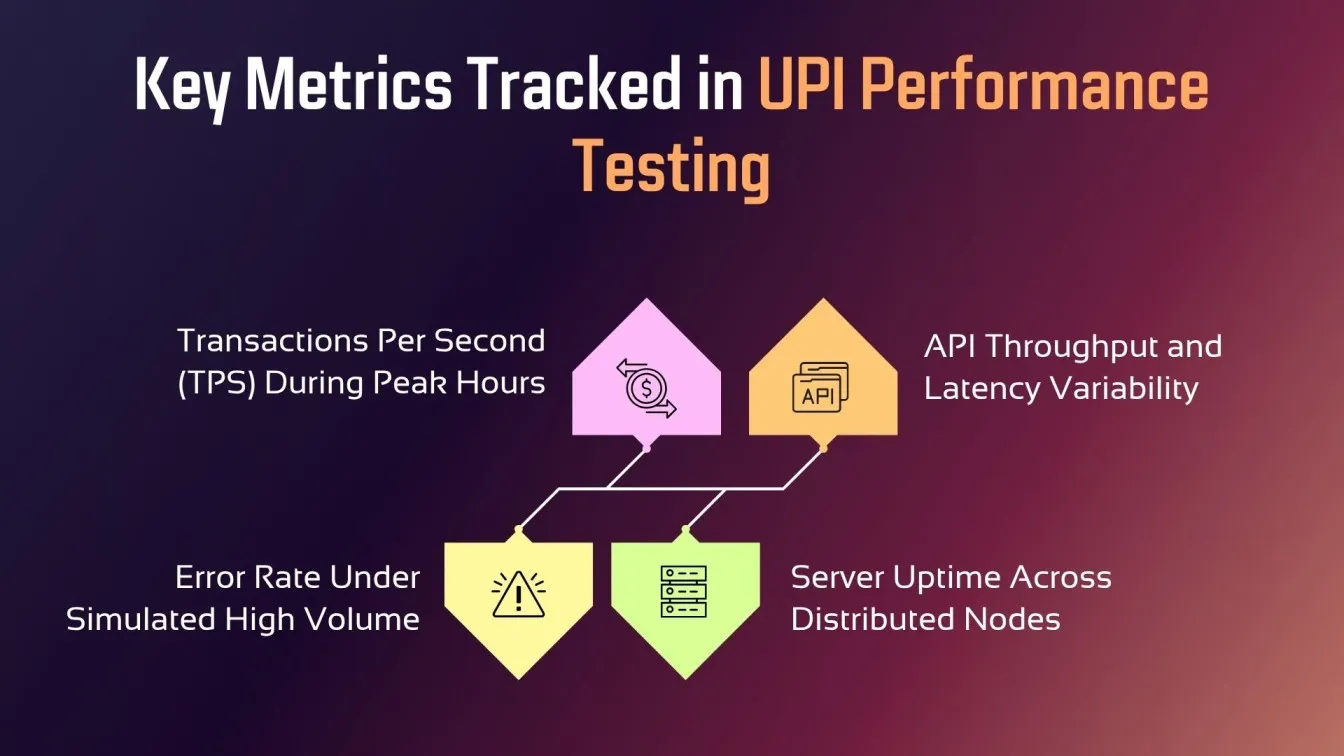
- Scalability Planning: Load testing tools are essential for simulating multiple concurrent transactions, helping teams assess how UPI transaction systems perform during heavy usage, especially in real-world peak hours.
- API Efficiency: To ensure seamless digital payments, API performance testing is applied to measure response times and detect bottlenecks, often supported by API load testing techniques that verify fast and secure transaction processing.
- Sustained Load Validation: Continuous testing with solutions like K6 load testing allows platforms such as Google Pay to maintain system integrity and payment consistency even under unexpected traffic spikes.
- Backend Endurance: Using JMeter performance testing, testers evaluate the backend's capacity to process high transaction volumes while maintaining speed and minimizing latency issues for end users.
- Future-Ready Systems: Through comprehensive performance testing services, developers ensure that the UPI unified payment interface is optimized to scale reliably with the growing demands of the digital economy and evolving user expectations.
System Reliability Testing Behind UPI’s High Success Rate
UPI undergoes rigorous system reliability testing to maintain its status as India’s most trusted real-time payment system. This ensures uninterrupted service, scalability during peak traffic, and consistent transaction success rates. The seamless experience of UPI payments, whether through Google Pay, Mobile Wallets, or Bharat QR is backed by a robust digital infrastructure and thorough validation of performance under stress. Below are essential factors contributing to UPI’s reliability:
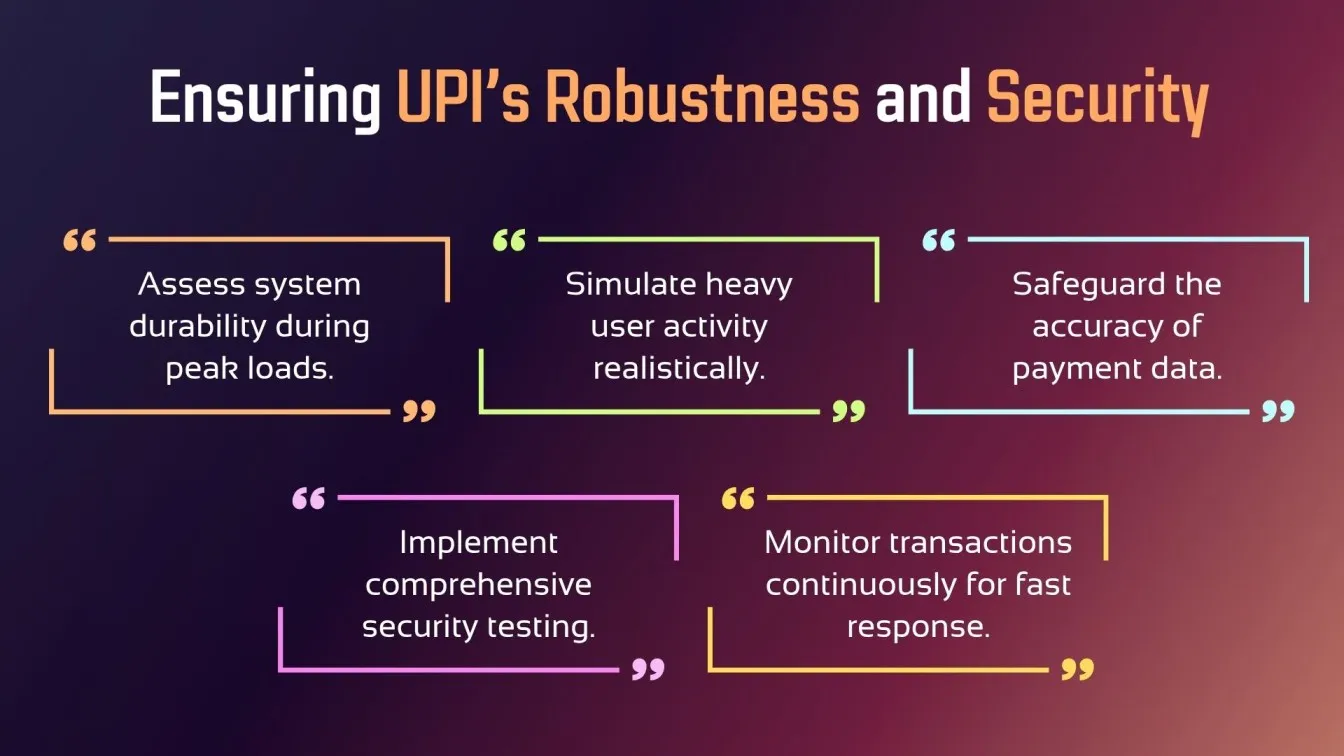
- System resilience testing: Ensures stability across different banking partners like ICICI Bank, IDFC First Bank, and Canara Bank during failures or network disruptions.
- High concurrency simulation: Uses load testing tools such as Gatling load testing, k6 performance testing, and JMeter performance testing to replicate massive concurrent users during economic activities like festive seasons.
- Data integrity checks: Protects digital transactions and bank account details while supporting formal credit and daily transactions across India.
- Security layers: Integrated with application security testing and web application security testing to maintain user trust and the Indian government's digital agenda.
- Real-time monitoring systems: Enable instant alerts and response strategies, contributing to the system’s reputation in the Digital Payments Revolution.
How End-to-End Test Cases Enhance UPI Functionality
End-to-end test cases are crucial for validating UPI functionality across varied platforms and user journeys. As UPI Lite and advanced modes of payment like Bharat QR gain momentum, testing ensures seamless integration and performance. These test cases simulate real-world digital payment transactions to detect failures before public release.
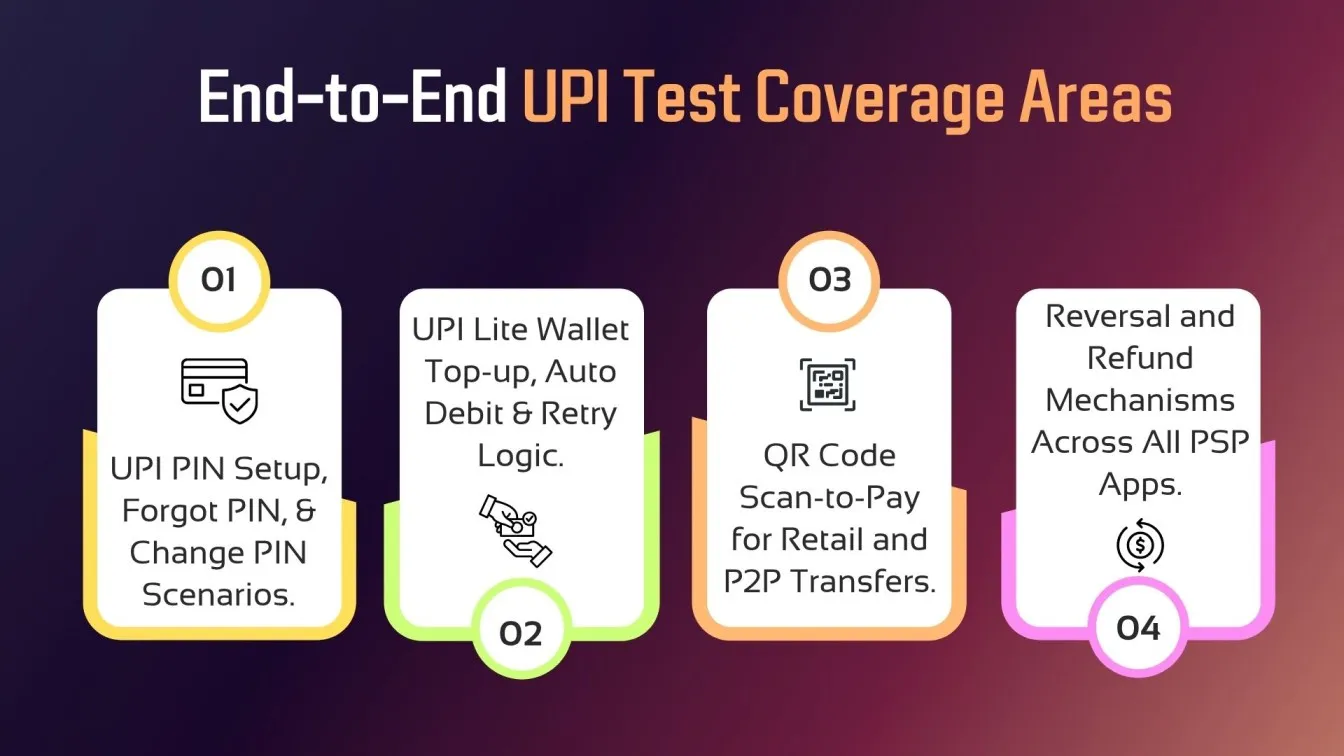
- Digital revolution: Ensures UPI keeps pace with the evolving digital payment market across mobile and web interfaces.
- Modes of payment: Tests Virtual Payment Address (VPA), code payment, and Aadhaar-based flows across banking apps and wallets.
- Traditional banks: Verifies UPI interoperability across systems like Kotak Mahindra Bank, IndusInd Bank, and central banks.
- Cross-border transactions: Confirms functionality across borders with entities like Bank of Thailand and Nepal Rastra Bank.
- Public infrastructure: Validates performance under real conditions aligned with initiatives by NPCI International Payments Limited and supported by government intervention.
Automated Test Cases and Continuous Integration in UPI Development
As UPI transforms the digital payment ecosystem, automated test cases and continuous integration pipelines play a key role in maintaining system stability. These practices allow real-time validation of features across banking apps, mobile wallets, and codebases, ensuring high performance and secure financial transactions.
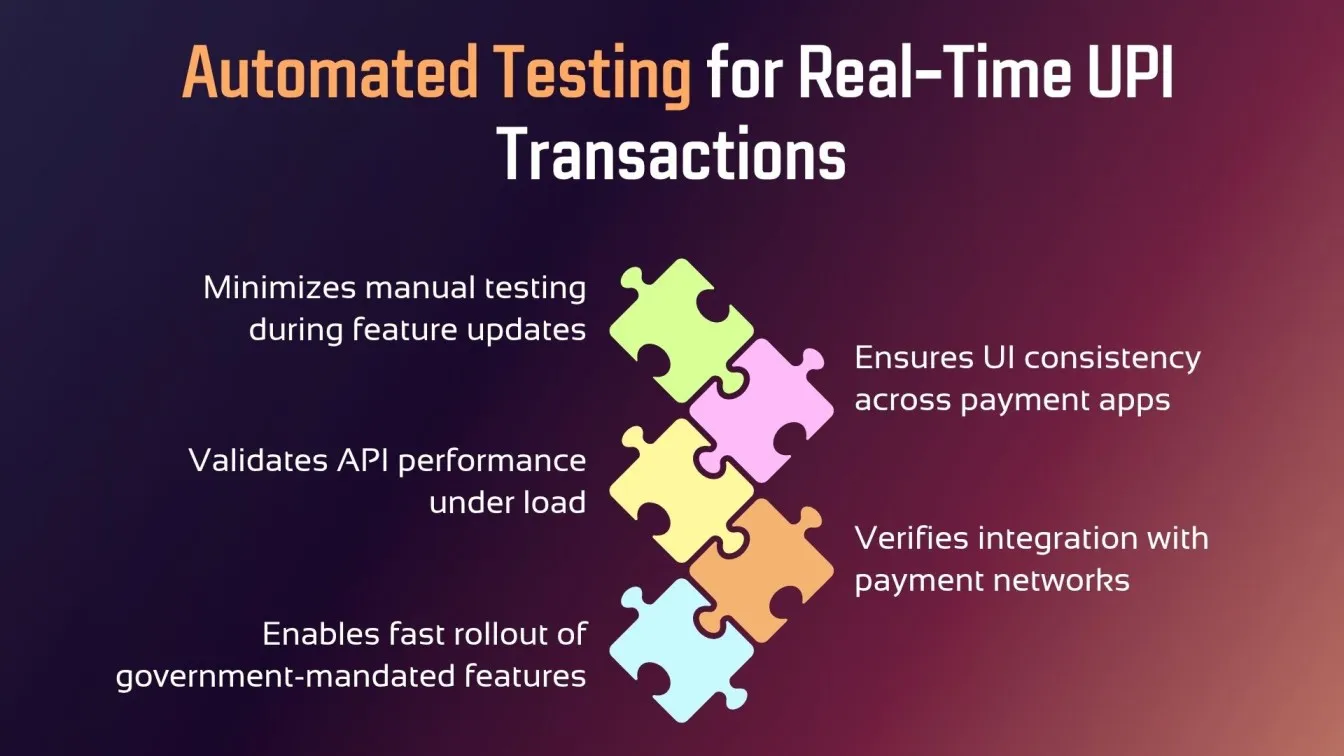
- Automated test cases reduce manual efforts during UPI feature releases and speed up debugging in digital payment platforms.
- Continuous integration ensures UI consistency and compliance across apps like Google Pay and Bharat QR.
- Automated testing validates backend API performance testing under increasing transaction volumes.
- Integration tests confirm smooth compatibility with credit cards and existing payment networks for hybrid payment support.
- Testing automation supports timely updates aligned with government initiatives promoting a cashless society.
The Importance of Non Functional Testing in UPI Ecosystem
As UPI payments continue transforming the digital payment ecosystem, non functional testing ensures the infrastructure remains resilient, secure, and scalable. From google pay to mobile application interfaces, testing helps maintain trust and system reliability in India’s growing digital revolution.
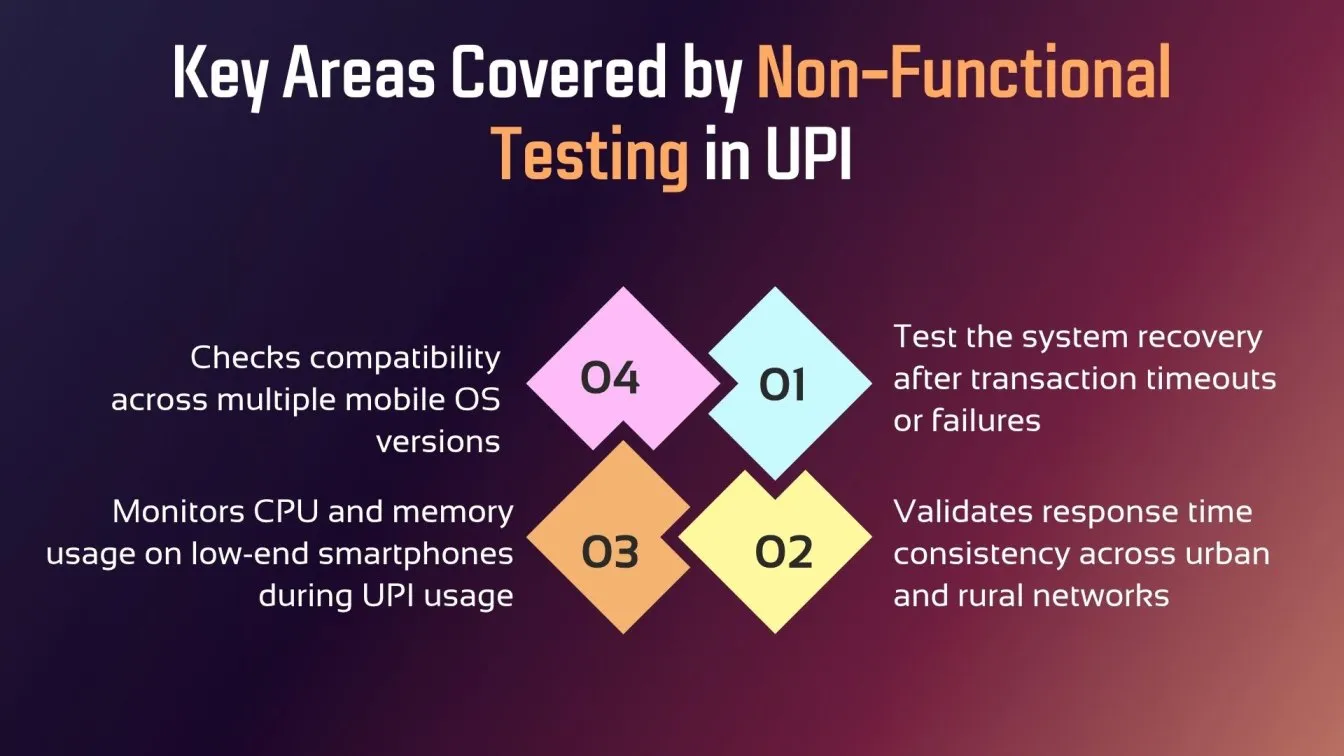
- Performance testing tools: Help benchmark UPI pay platforms under high load during digital payment transactions.
- API performance testing: Ensures stable interaction between bank account details and apps like the Google Pay app across diverse modes of payment.
- Security testing services: Identify threats across platforms, supporting the security of digital payments and protecting financial institutions.
- JMeter performance testing: Simulates large-scale transaction loads across the digital payment infrastructure to ensure low latency and high success rates.
- Mobile app security testing: Validates app security for primary user and secondary user accounts, enhancing consumer trust in the UPI Unified Payment Interface.
Real-Time Payments and the Need for Robust Backend Testing
The success of real-time payment systems like UPI in India depends heavily on strong backend testing to maintain accuracy, speed, and user trust. With platforms like Google Pay online processing millions of digital transactions daily, backend validation ensures seamless execution, even under pressure from growing adoption rates and increased market share.

- API load testing: Verifies backend stability when handling concurrent UPI transaction requests from apps like Google Pay for Business.
- Load testing software: Assesses system endurance during massive spikes in digital payment transactions, especially during festivals or salary days.
- K6 load testing: Simulates real-time transaction flows to evaluate performance bottlenecks in critical backend infrastructure.
- Cyber security penetration testing: Identifies backend vulnerabilities, especially during cross-app data transfers across bank account details and card networks.
- Application security testing: Ensures backend systems uphold data integrity and prevent fraud across all modes of payment.
UPI Integration API and Its Role in Consistent User Experience
The UPI integration API plays a crucial role in delivering a seamless and reliable user experience in digital payment systems. This API is designed to facilitate easy integration of various payment gateways with UPI, ensuring smooth financial transactions across platforms. Here's how it contributes to a better experience:
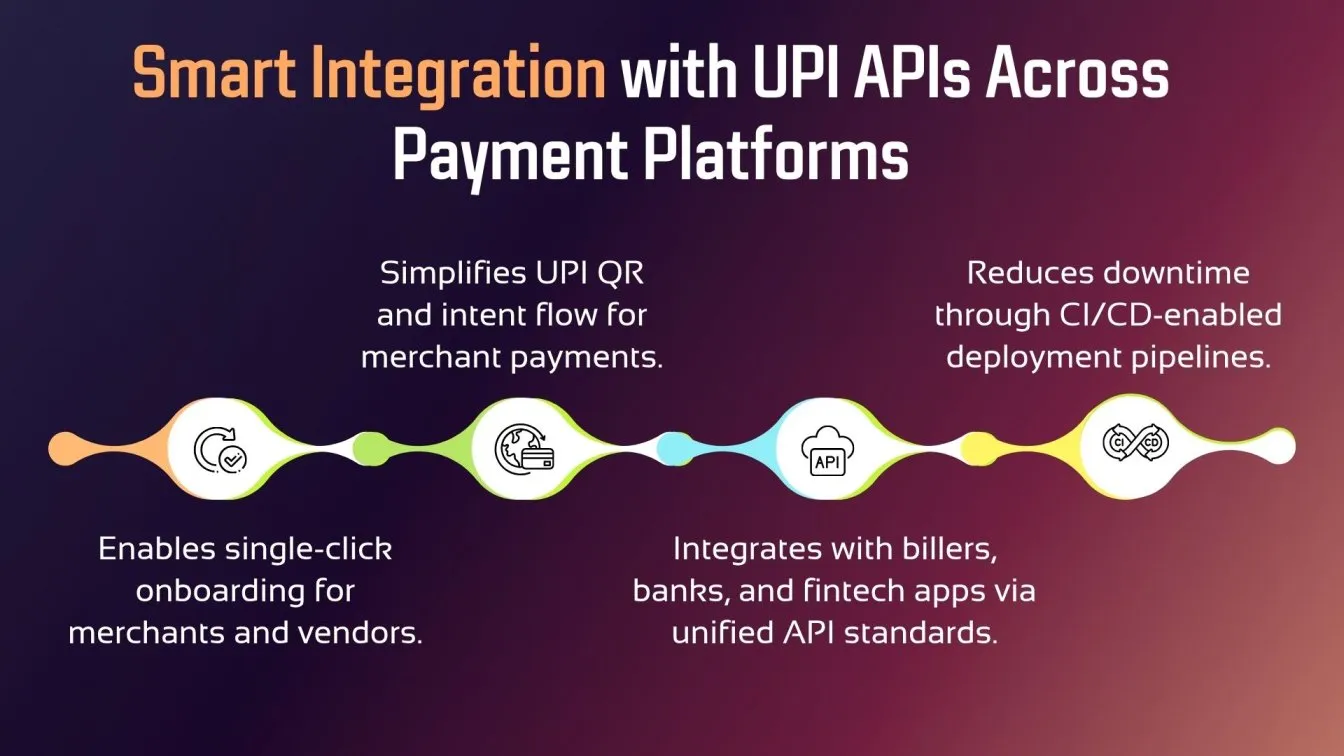
- Real-time payment system: The API supports immediate transaction processing, ensuring minimal delays and a consistent user experience.
- Security of digital payments: It integrates advanced security protocols like safeguarding transactions and user data.
- Future of digital payments: The API paves the way for more advanced features in the digital payments industry, addressing emerging digital payments trends.
- Cross-platform compatibility: It supports integration across various mobile apps, promoting digital payments trends and wider adoption.
Handling Spikes in UPI Transaction Volume with Scalable Architecture
As UPI continues to dominate digital payments in India, handling spikes in UPI transaction volumes becomes crucial to maintain a consistent user experience. A scalable architecture ensures the system can manage sudden surges in traffic without compromising performance. Here’s how scalability plays a vital role:
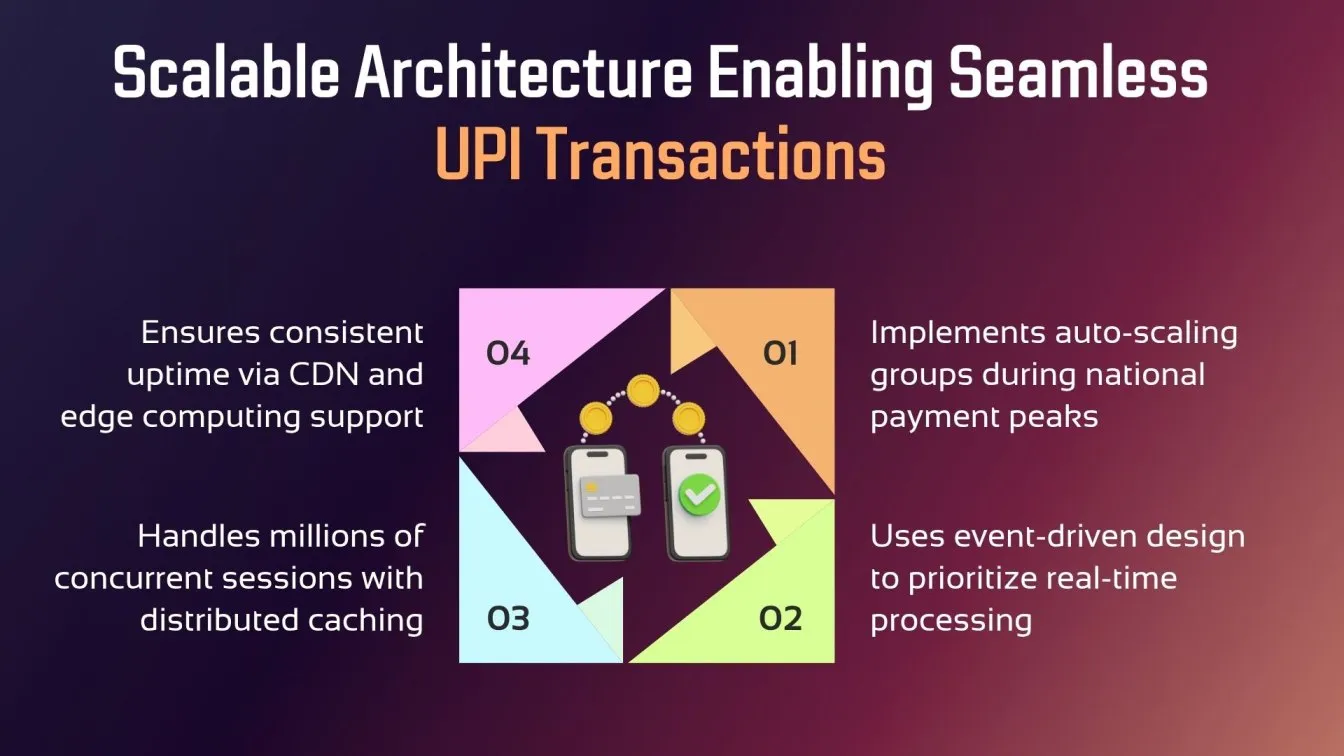
- Performance testing tools: Utilizing website performance testing and software performance testing ensures the system handles increased demand effectively.
- API load testing: Testing through API load testing helps identify bottlenecks, ensuring seamless transactions even during high usage periods.
- Security of digital payments: The system must maintain robust security testing services to protect sensitive data while scaling up during peak times.
- Digital payments trends: Scalable architecture supports the growing digital payments industry by adapting to the future of digital payments and evolving trends.
- Load testing tools: Employing tools like JMeter load testing and K6 performance testing helps validate system reliability under high transaction volumes.
How NPCI Maintains UPI Reliability Through Testing at Scale
The National Payments Corporation of India (NPCI) plays a key role in ensuring UPI's reliability by conducting extensive testing to address challenges like increased transaction volumes, performance issues, and security concerns. Their testing strategies are vital for maintaining UPI payments.
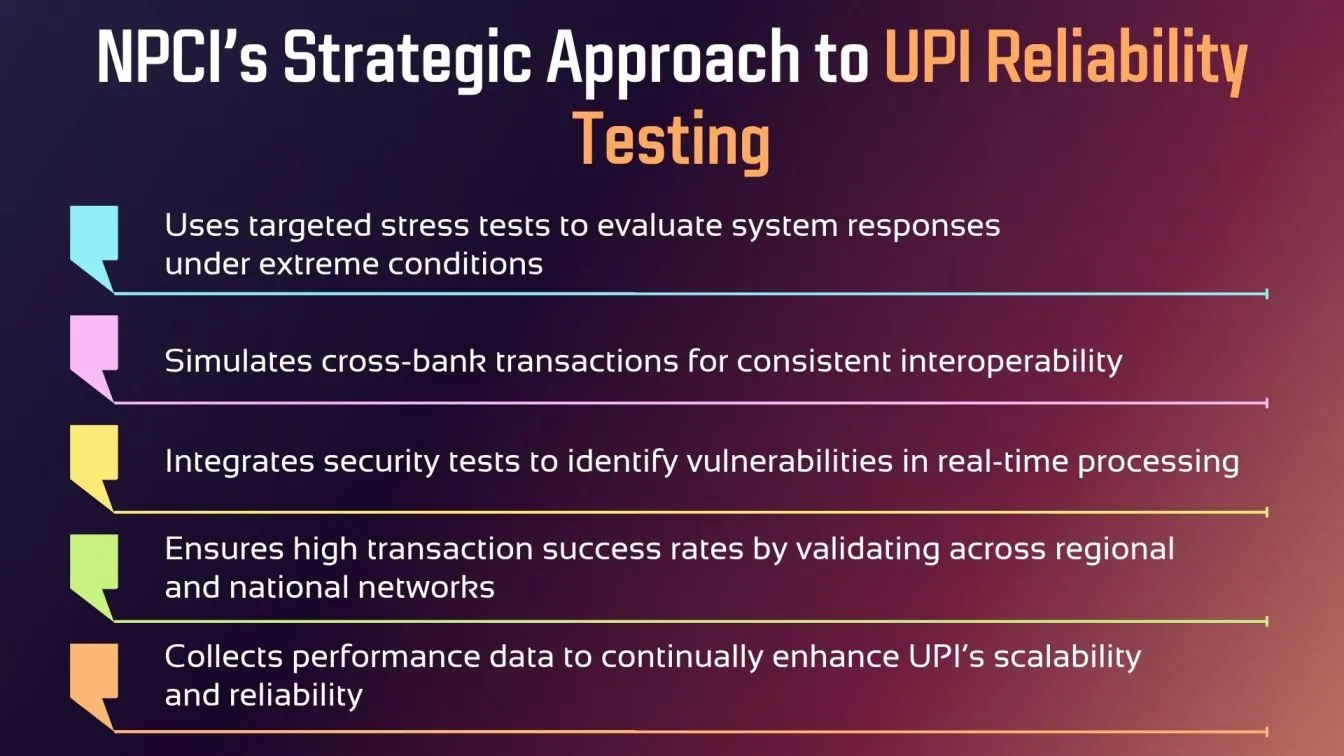
- Scalable infrastructure: Load testing tools such as JMeter and K6 performance testing are employed to simulate high traffic and ensure the UPI system can handle millions of transactions seamlessly without performance degradation.
- Continuous monitoring: Regular website performance testing is conducted to assess UPI's response times and availability, ensuring optimal performance during peak usage times.
- API testing: With API security testing, NPCI ensures that all UPI interfaces are secure and that transactions remain protected from cyber threats.
- Stress testing: NPCI applies stress testing methods to simulate high traffic volumes and determine the system's ability to recover and handle sudden spikes in transaction load.
- Performance metrics: By leveraging performance testing services, NPCI monitors critical metrics such as transaction time and system stability to ensure that UPI remains reliable for users across India.
Final Thoughts
In conclusion, UPI’s seamless scalability, robust security, and continuous testing are pivotal to its success in India’s digital payments ecosystem. By leveraging tools like API load testing, performance testing, and security testing services, UPI ensures efficient handling of growing transaction volumes. Its integration into daily life through services like UPI AutoPay reflects its rapid adoption across both public and private sector platforms. As the digital payments industry evolves with a steady annual growth rate, UPI's innovative approach continues to drive the future of digital payments in India, making it a reliable and trusted platform for users.
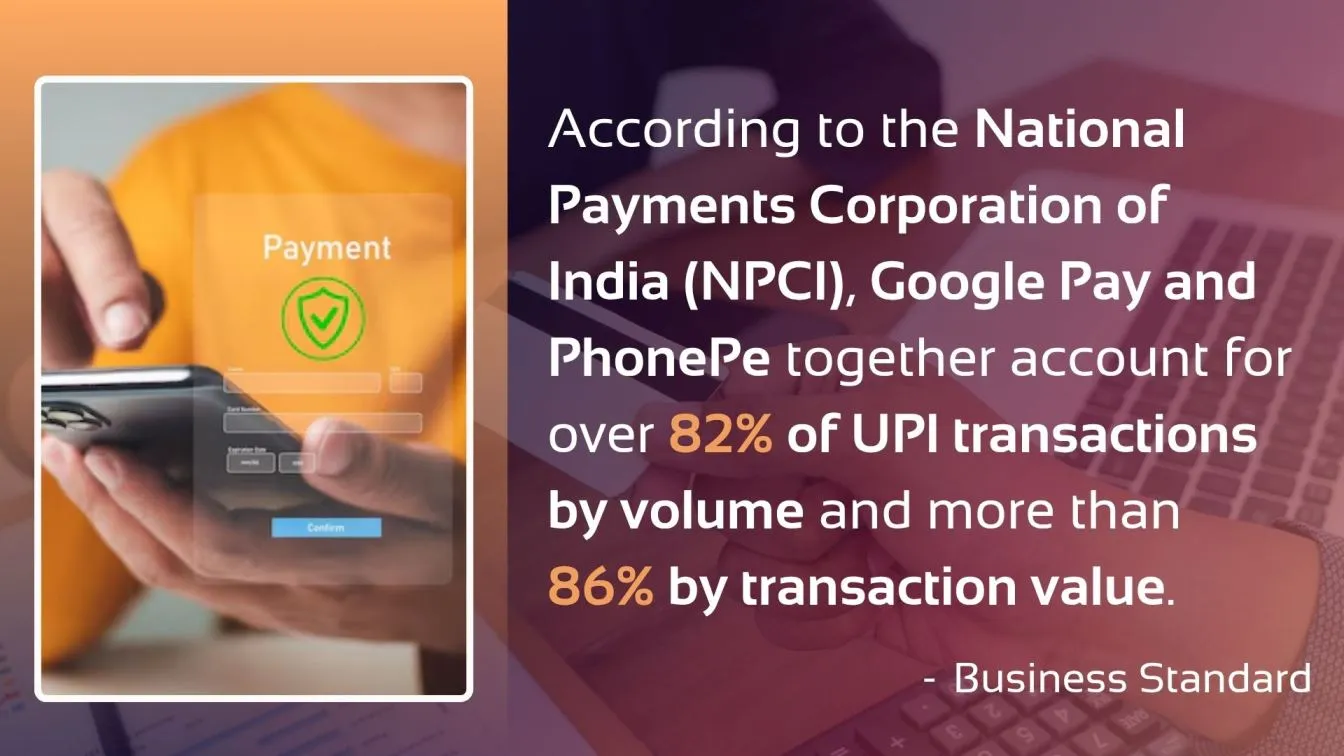
As UPI continues to thrive, ensuring seamless transactions and scalability is key. Frugal testing companies like Frugal Testing offer valuable insights through functional testing services, enabling reliable performance. Tools like JMeter pricing help evaluate system robustness. Collaborating with top software testing companies and offering QA testing services for enterprises, providers ensure that the UPI integration API is equipped to handle growing demands, ensuring a smooth digital payments industry experience.
People Also Ask
What is UPI's contribution to India's cashless economy from a performance testing perspective?
UPI’s performance testing ensures high transaction volume handling, providing a seamless, reliable digital payment experience, which supports India’s cashless economy.
Why is continuous performance testing essential for a real-time system like UPI?
Continuous performance testing ensures UPI can handle real-time transactions efficiently, maintaining stability and speed under varying load conditions.
What are the key factors in testing website performance for UPI-integrated platforms?
Key factors include load handling capacity, transaction speed, uptime reliability, and seamless API responsiveness during peak usage.
How does penetration testing help identify UPI system vulnerabilities?
Penetration testing simulates cyberattacks to uncover security flaws and prevent unauthorized access in UPI systems.
How does penetration testing help identify UPI system vulnerabilities?
Penetration testing simulates cyberattacks to identify potential weaknesses in UPI’s security framework, enabling proactive vulnerability fixes.





%201.webp)

